#Middle Eastern Indian & N. African Weapons
Explore tagged Tumblr posts
Text

This custom crafted Turkish Kilij was forged by swordsmith Kılıç Osman Başkurt in Turkey and has a blade of well-tempered 6150 high carbon steel with a hardness of about 50 – 55 HRc. The guard and pommel are mild steel that has a rough equivalency to 1020 steel and the well-carved and finely polished wood grip is stabilized Turkish boxwood. The sword is matched with a wooden scabbard which is bound in blackened goat leather and completed with steel fittings.
✨ In Stock and Available to order now ✨
#Kult of Athena#KultOfAthena#Kılıç Osman Başkurt#Kilic Osman Baskurt#Early Ottoman Turkish Kilij#sword#swords#weapon#weapons#blade#blades#Kilij#Turkish Swords#Turkish Weapons#Asian Swords#Asian Weapons#Middle Eastern Swords#Middle Eastern Weapons#Middle Eastern Indian & N. African Swords#Middle Eastern Indian & N. African Weapons
5 notes
·
View notes
Text
World leaders gather in Paris to mark 100 years since WWI Armistice | News | DW
Some 70 world leaders gathered at the famous Arc de Triomphe in the French capital, Paris, on Sunday to mark 100 years since the end of World War One.
Commemorations in Paris had been scheduled to begin at 11 a.m. local time (1000 UTC), the time that the Armistice signed by the Allies and the Germans on November 11, 1918, went into force. However, the proceedings were slightly delayed, with leaders arriving too late for the exact moment.
The large number of countries represented in Paris reflects the widespread nature of a conflict in which an estimated 37 million people, including 10 million soldiers, lost their lives. The city of Paris itself was a key objective in the war, with the Allies fighting successfully against German efforts to capture it in 1914.
Solemn ceremonies held worldwide to mark WWI armistice centenary
New Zealand leads the remembrance
A 10-cannon salute was held at the Wellington waterfront on Sunday morning to mark the armistice centenary. A kilometer away at Pukeahu National War Memorial Park, hundreds of people gathered for a service attended by Prime Minister Jacinda Ardern. Some 100,000 New Zealand soldiers and nurses served overseas in World War I, and more than 16,000 never came back.
Solemn ceremonies held worldwide to mark WWI armistice centenary
Poppies adorn Sydney Opera House
The sails of Sydney’s iconic opera house were illuminated with red poppies for Remembrance Day to signify the bright red flowers that grew on the Western Front battlefields following the war. Around a sixth of Australia’s then less than 5 million population enlisted to fight. More than half of them were either killed, wounded, gassed or taken prisoner.
Solemn ceremonies held worldwide to mark WWI armistice centenary
Asian countries pay respects to war dead
Observances were held in Myanmar and Hong Kong (pictured), where school children laid wreaths in remembrance at the Cenotaph war memorial, while veterans saluted. In India, a ceremony at New Delhi’s War Cemetary was attended by relatives of many soldiers. The Indian Army sent a million troops to Africa, the Middle East and Europe to fight in World War I.
Solemn ceremonies held worldwide to mark WWI armistice centenary
World leaders gather in Paris
A moving armistice ceremony was held in Paris, watched by around 70 world leaders including German Chancellor Angela Merkel and US President Donald Trump. The leaders missed the exact moment of the armistice anniversary as they were running late. The memorial included classical music and the reading aloud of letters by WWI soldiers.
Solemn ceremonies held worldwide to mark WWI armistice centenary
Millions of fallen soldiers remembered
France’s Republican guards took part in the parade close to Paris’ Arc de Triomphe. At the exact moment 100 years ago that Allied and German weapons fell silent, French Fighter jets passed over the commemorations. Hundreds of miles away, bells rang across Europe’s Western Front, the main theater of conflict during World War I.
Solemn ceremonies held worldwide to mark WWI armistice centenary
Britain’s royals lay wreaths
Britain’s commemorations at the Cenotaph war memorial in London were led by the Queen, who watched from a nearby balcony, and Prime Minister Theresa May. Princes William and Harry also laid wreaths for the 900,000 British soldiers killed in the ‘Great War.’
Solemn ceremonies held worldwide to mark WWI armistice centenary
Steinmeier’s ‘historic act of reconciliation’
German President Frank-Walter Steinmeier became the first German head of state to attend the annual Remembrance commemorations in London. The British government said before the ceremony that he would lay the wreath at the Cenotaph “on behalf of the German people in a historic act of reconciliation.” Germany lost 1.8 million soldiers out of 13 million mobilized for World War I.
Solemn ceremonies held worldwide to mark WWI armistice centenary
Respect for lives lost on the Eastern Front
While Russian President Vladimir Putin attended the armistice centenary observance in Paris, Russia’s military paid its own respects at a cemetery for WW1 heroes near St Petersburg. Members of military history clubs donned ‘Great War’-era military uniforms to mark the occasion. More than 2.4 million Russians lost their lives in one of the world’s most devasting conflicts.
Author: Nik Martin
The solemn ceremony, held in rainy conditions, featured schoolchildren reading moving messages written by soldiers in eight languages, as well as musical performances, including by French-born Chinese-American cellist Yo-Yo Ma and West African singer Angelique Kidjo.
Patriotism, not nationalism
French President Emmanuel Macron held an address in which he described the joy at the end of the conflict, but also remembered the horrors and millions of dead and wounded.
In his speech, he called the nationalism that underlay the war a betrayal of patriotism. He appealed for friendship and dialogue between the nations to create a peaceful future.
“The old demons are rising again,” Macron said. “We must reaffirm before our peoples our true and huge responsibility: that of passing on to our children the world that previous generations dreamed of.”
“Together, we can banish the specters of climate change, poverty, hunger, illness, all the inequalities and every ignorance,” he added Read more: World War I: Europe and the politics of remembrance
Macron stressed the dangers of nationalism in his speech
Far-flung conflict
The Paris commemorations were preceded by ceremonies in New Zealand, Australia, India, Hong Kong and Myanmar, former British colonies that lost tens of thousands of people sent to fight in the war.
Although Sunday’s ceremonies celebrate an act that brought a short-lived peace to the world, they are taking place at a time of growing nationalism and international tensions.
US President Donald Trump, one of the leaders attending the event, is seen by many as undermining the Western alliance and world bodies such as the UN with his self-declared nationalism. Trump will not be present at the Paris Peace Forum scheduled to take place after a memorial service on the Champs-Elysees. The conference was conceived by Macron and aims to highlight the importance of international institutions for global peace and prosperity.
The Forum is to be opened with a speech given by German Chancellor Angela Merkel alongside UN Secretary General Antonio Guterres.
Trump, with his wife Melania, sat next to Merkel during the ceremony
Some of those who participated in Sunday’s commemorations had relatives who fought in what is often known as the “Great War,” and had come a long way to be in Paris, as DW’s Bernd Riegert reported.
Some protest
Other attendees of the memorial service and Forum included Canadian Prime Minister Justin Trudeau, Turkish President Recep Tayyip Erdogan, Israeli Prime Minister Benjamin Netanyahu, and Russian President Vladimir Putin.
Trump and Putin greeted each other and shook hands at the ceremony, Russian television showed. The gesture comes as relations between their two countries remain strained, among other things because of alleged Russian interference in recent US elections.
The US president pointedly did not extend his hand to Trudeau. Earlier this year, Trump described the Canadian premier as “dishonest and weak” amid a dispute over what he alleges are Canada’s “unfair” trade practices.
As Trump’s motorcade made its way up the Champs-Elysees, it was temporarily halted after two topless protesters approached it wearing slogans on their bodies. Police quickly overpowered the protesters, whom the feminist group Femen claimed as its own.
British commemorations
In Britain, German President Frank-Walter Steinmeier laid a wreath at a commemoration ceremony held at the Cenotaph war memorial in central London. He arrived with Prince Charles, who laid the first wreath on behalf of his mother, Queen Elizabeth II, who watched on from a nearby balcony.
Steinmeier was the first German leader to join the annual remembrance ceremony in Britain
Ahead of the ceremony, the British government said Steinmeier’s wreath was laid “in a historic act of reconciliation.”
Other smaller ceremonies were held in other places across Britain, including Cardiff, Belfast and Glasgow.
tj/rc (AFP, AP)
Each evening at 1830 UTC, DW’s editors send out a selection of the day’s hard news and quality feature journalism. You can sign up to receive it directly here.
document.addEventListener("DOMContentLoaded", function (event) { if (DWDE.dsgvo.isStoringCookiesOkay()) { facebookTracking(); } }); function facebookTracking() { !function (f, b, e, v, n, t, s) { if (f.fbq) return; n = f.fbq = function () { n.callMethod ? n.callMethod.apply(n, arguments) : n.queue.push(arguments) }; if (!f._fbq) f._fbq = n; n.push = n; n.loaded = !0; n.version = '2.0'; n.queue = []; t = b.createElement(e); t.async = !0; t.src = v; s = b.getElementsByTagName(e)[0]; s.parentNode.insertBefore(t, s) }(window, document, 'script', 'https://connect.facebook.net/en_US/fbevents.js'); fbq('init', '157204581336210'); fbq('track', 'ViewContent'); } Source link
The post World leaders gather in Paris to mark 100 years since WWI Armistice | News | DW appeared first on Today News Stories.
from WordPress https://ift.tt/2PqoDbX via IFTTT
0 notes
Text

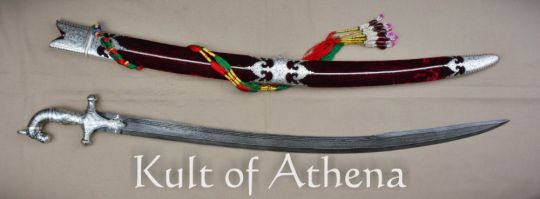
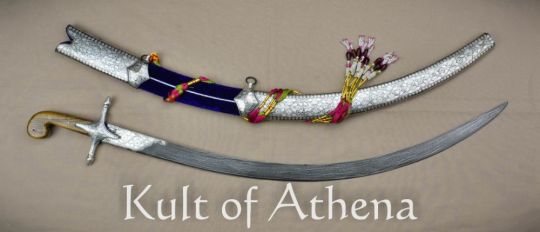

Universal Swords:
Damascus and Silver Koftgari Indian Khanda Sword
Damascus and Silver Koftgari Indian Saber
Damascus and Silver Koftgari Indian Shamshir
Damascus and Silver Koftgari Indian Tiger’s Head Shamshir
#Kult of Athena#KultOfAthena#Universal Swords#Koftgari#Damascus and Silver Koftgari Indian Khanda Sword#Damascus and Silver Koftgari Indian Saber#Damascus and Silver Koftgari Indian Shamshir#Damascus and Silver Koftgari Indian Tiger’s Head Shamshir#Damascus Steel#Middle Eastern Indian & N. African Swords#Middle Eastern Indian & N. African Weapons#sword#swords#weapon#weapons#blade#blades#Shamshir
24 notes
·
View notes
Text
instagram
If you are interested in Middle Eastern weapons and armor, give @baytalasad a follow. They teach at seminars across the states, and currently work with the Worcester Art Museum in MA, where they do educational, demonstrations of Middle East arms and armor.
#Kult of Athena#KultOfAthena#WorldOfKOA#kilij#shamshir#educational#swords#swordsman#Middle Eastern Indian & N. African Swords#Middle Eastern Indian & N. African Weapons#armor#armour#Instagram
3 notes
·
View notes
Text
instagram
Universal Swords Turkish Kilij: Initial Impressions by sellsword.arts
#Kult of Athena#KultOfAthena#Turkish Kilij#Universal Swords#sellsword.arts#sword#swords#weapon#weapons#blade#blades#Kilij#Turkish Swords#Turkish Weapons#Asian Swords#Asian Weapons#Middle Eastern Swords#Middle Eastern Weapons#Middle Eastern Indian & N. African Swords#Middle Eastern Indian & N. African Weapons#Instagram#videos#sabers#1065 High Carbon Steel#Battle Ready#Turko-Mongol sabers#Asiatic stepp#Caucasus cavalrymen
3 notes
·
View notes
Text




LK Chen – Persian Shamshir
Swift in the hand and a ferocious cutter, the legendary Persian Shamshir is now made available by LK Chen in a form eminently practical and suitable for routine and regular cutting practice and demonstration and takes its inspiration from a 19th century historic original which is now housed with the collection of the New York MET Museum and is a famous example bequeathed by George C. Stone in 1935. The sharpened blade is crafted from well tempered GB 60Si2MnA High Carbon Manganese Spring Steel and it is securely pinned and mounted into a hilt with steel fittings and a smoothly polished wooden grip. The long tang is pinned directly to the grip halves for a secure mounting and melding of blade and hilt furniture. The sword is matched with a wood core scabbard which is bound in black leather and completed with fittings of steel and stainless steel.
Although “Shamshir” in Persian culture became a byword for swords in general, the name originally meant “curved like a lion’s claw” – a self evident reference to its blade shape and the vicious “bite” of its slash. The sharp curve of the blade slices deeply into and through the target as the sword blade “pivots” around its impact point as the cutting arm goes through its plane of movement. Persian swords before the 9th century were originally straight-bladed, but after influence from both the Seljuk Turks and the Mongols the Shamshir took on its familiar form in Persia. Although optimized for cutting, particularly from atop a swift and light-footed horse, the Shamshir is also capable of powerful thrusts. Although the angle from which a thrust can be executed is not as straightforward as a straight sword, the sharp curvature of the blade allows for a skilled swordsman to strike home that thrust from unpredictable angles which can be difficult to anticipate or defend from.
#Kult of Athena#KultOfAthena#New Item Wednesday#LK Chen#Persian Shamshir#Middle Eastern Indian & N. African Swords#Middle Eastern Indian & N. African Weapons#sword#swords#weapon#weapons#blade#blades#19th century#New York MET Museum#GB 60Si2MnA High Carbon Manganese Spring Steel#Battle Ready
10 notes
·
View notes
Text
instagram
LK Chen – Persian Shamshir
The sharpened blade is crafted from well tempered GB 60Si2MnA High Carbon Manganese Spring Steel and it is securely pinned and mounted into a hilt with steel fittings and a smoothly polished wooden grip. The long tang is pinned directly to the grip halves for a secure mounting and melding of blade and hilt furniture. The sword is matched with a wood core scabbard which is bound in black leather and completed with fittings of steel and stainless steel.
#Kult of Athena#KultOfAthena#LK Chen#Persian Shamshir#Middle Eastern Indian & N. African Swords#Middle Eastern Indian & N. African Weapons#sword#swords#weapon#weapons#blade#blades#19th century#New York MET Museum#GB 60Si2MnA High Carbon Manganese Spring Steel#Battle Ready#video#videos#Instagram
9 notes
·
View notes
Text


✨ 2 New Sabers from Universal Swords✨
These ornate and entirely handcrafted sabers from India with their damascus blade and koftgari-inlay embellishment is in itself a display of the traditional swordsmithing arts of India. The damascus steel blade features panels of silver inlay on both sides of the blade. The blade tang is secured by filling the hollow hilt and grip with a hardened resin to solidly anchor it into the hilt. This method of sword construction is a traditional technique in India.
Each sword is paired with a wood-core scabbard overlaid in vibrant velvet.
Damascus and Silver Koftgari Indian Saber with Ram’s Head
Damascus and Silver Koftgari Indian Saber with Hand design
In stock and available to order now.
#Kult of Athena#KultOfAthena#Koftgari Indian Saber#Damascus and Silver Koftgari Indian Saber with Ram’s Head#Damascus and Silver Koftgari Indian Saber with Hand design#Universal Swords#Middle Eastern Indian & N. African Swords#sword#swords#weapon#weapons#blade#blades#sabers#Damascus Steel#Battle Ready#Indian Swords#Indian Weapons#Middle Eastern Swords#Middle Eastern Weapons
2 notes
·
View notes
Text
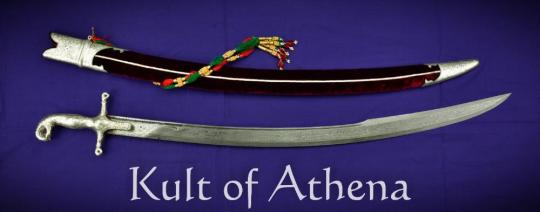
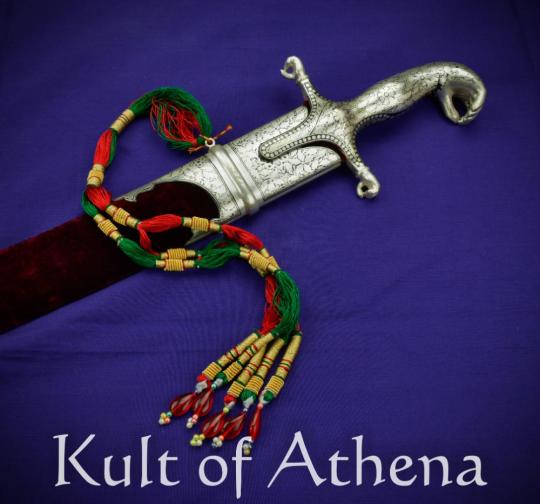
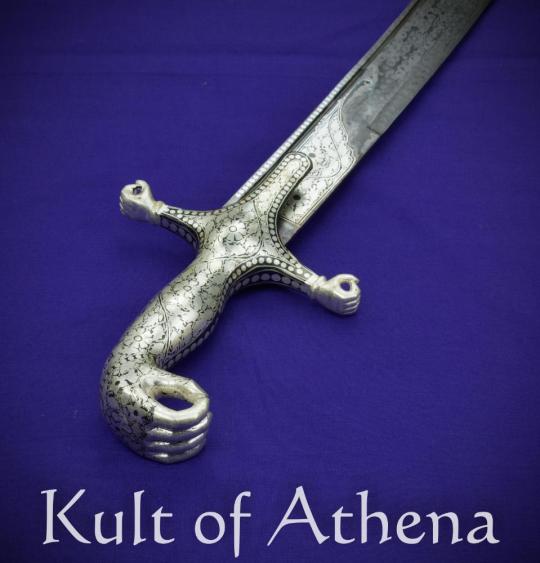

Damascus and Silver Koftgari Indian Saber with Hand design – Universal Swords
This ornate and entirely handcrafted saber from India with its damascus blade and koftgari-inlay embellishment is in itself a display of the traditional swordsmithing arts of India. The damascus steel blade features panels of silver inlay on both sides of the blade. The blade tang is secured by filling the hollow hilt and grip with a hardened resin to solidly anchor it into the hilt. This method of sword construction is a traditional technique in India.
The sword is paired with a wood-core scabbard overlaid in vibrant velvet. Its steel components were decorated with silver koftgari to match the sword. The Damascus steel blade is crafted from the melding of two different steels into a single billet from which the smith forges the blade; the mixed steel leaves a vibrantly visible rippled patterning on the blade surface. Traditionally this was a technique done to merge harder and softer steels into a single blade to impart it with both a hardness for durability and edge retention and a degree of flexibility to prevent the blade from becoming brittle.
This was done to get good results from the quality of iron available for smithing. Damascus is now technically inferior to pure steel made from modern industrial-scale methods, but it is still desired as the beauty of Damascus is instantly notable and is a testament to the skill of the smith who forged it with the traditional methods and the blade was further embellished with silver inlay at the base of the blade. The elegant and intricate design and patterning on the hilt was created with the laborious Koftgari technique; a traditional process exemplified by Indian smiths whereby a design is etched and chiseled and then strands of silver wire is carefully hammered into the etched design. The hilt is then heated in a kiln and the silver wire is then permanently annealed into a permanent design.
The patterning of the damascus blade varies with each blade in much the same manner as all fingerprints differ. Also the Koftgari designs are made to the individual design and artistry of the smith. Therefore every one of the swords of this type are uniquely crafted and are a testament to the traditional swordsmithing techniques of India.
Please Note: Unique Item – Only One Available!
#Kult of Athena#KultOfAthena#New Item Wednesday#Koftgari Indian Saber#Damascus and Silver Koftgari Indian Saber with Hand design#Universal Swords#Middle Eastern Indian & N. African Swords#sword#swords#weapon#weapons#blade#blades#sabers#Damascus Steel#Battle Ready#Indian Swords#Indian Weapons#Middle Eastern Swords#Middle Eastern Weapons
2 notes
·
View notes
Text
instagram
✨KOA Exclusive – Persian Shamshir / Scimitar✨
🗡️Back by popular demand! Kult of Athena has a limited stock available of this classic Windlass sword which we commissioned Windlass to produce for us in a special production run🗡️
The Persian Shamshir is a recreation of this iconic sword of the Middle East – this saber is not only light and nimble, but the curved blade is optimized for decisively deep cutting and quick slashes and in skilled hands the sword is a surprisingly capable piercing weapon which can strike its target at unpredictable angles. The hilt has a comfortable grip of well-polished wood with an enlarged pommel which neatly couches against the back of the hand for a sure grip. The crossguard is made from metal with an antiqued silvered finish and the blade tang is dual-riveted into the grip for a solid overall construction.
#Kult of Athena#KultOfAthena#videos#Instagram#Persian Shamshir#Persian Scimitar#Scimitars#Shamshirs#sword#swords#weapon#weapons#blade#blades#KOA Exclusive#Middle Eastern Indian & N. African Swords#Middle Eastern Indian & N. African Weapons#Battle Ready#1065 High Carbon Steel#Windlass Steelcrafts#Middle Eastern Swords#Middle Eastern Weapons
2 notes
·
View notes
Text
instagram
Persian Shamshir from @kult_of_athena Review!
video via sellsword.arts
#Kult of Athena#KultOfAthena#sellsword.arts#videos#Instagram#Persian Shamshir#Persian Scimitar#Scimitars#Shamshirs#sword#swords#weapon#weapons#blade#blades#KOA Exclusive#Middle Eastern Indian & N. African Swords#Middle Eastern Indian & N. African Weapons#Battle Ready#1065 High Carbon Steel#Windlass Steelcrafts#Middle Eastern Swords
2 notes
·
View notes
Text





EGKH – Tactical Scimitar
This Tactical Scimitar from the Ex Gurkha Khukuri House of Nepal has a burly and hard-hitting blade of 5160 high carbon steel. The blade was differentially-tempered to possess a dull-resistant 58-60 HRc, a body of 45-46 HRc and a shock absorbing spine of 22-25 HRc. The sweeping blade delivers powerful slashes and deep cuts to a target and the polished wooden grip gives the bearer plenty of leverage with which to wield the sword. The tang runs for about 3/4 of the length of the handle.
The high quality scabbard is crafted from wood which is bound in leather and completed with a faux leather belt loop so that the sword can be worn vertically; it can also be worn across the shoulder with its adjustable shoulder baldric. Integrated with the scabbard is a pair of buttoned retaining straps to secure the hilt.
#Kult of Athena#KultOfAthena#Ex Gurkha Khukuri House#EGKH#Tactical Scimitar#sword#swords#weapon#weapons#blade#blades#Scimitars#Asian Swords#Asian Weapons#Middle Eastern Indian & N. African Swords#Middle Eastern Indian & N. African Weapons#Nepal#Nepalese Weapons#Nepalese Swords#Tactical Weapons#Tactical Swords
2 notes
·
View notes
Text
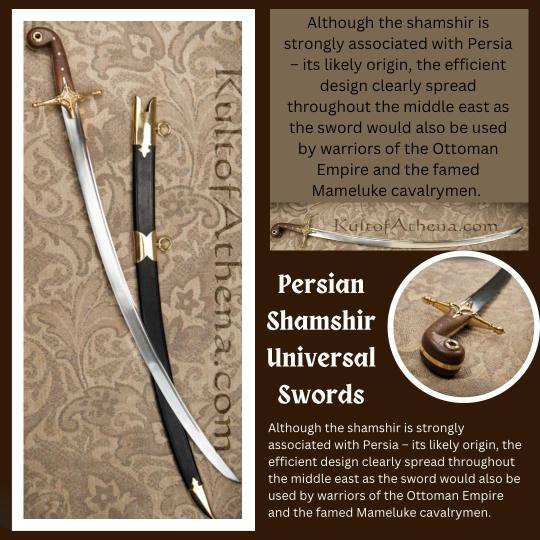
Not merely pleasing to the eye, the curve of the Shamshir or Scimitar creates a blade designed to cut deeply and swiftly. As the blade enters the target on the bottom of the blade curve, the angle of the tip as it passes through the target ensures that the wound is made as deep as possible. Though the blade is curved, in skilled hands it can be a sword that can bring a surprising thrust to an opponent who expects a slashing sword when he glances at its appearance.
Like historical examples, this reproduced Shamshir is a swiftly striking blade that feels quick and responsive in the hand. The curved grip with a swollen pommel not only acts as a backstop to keep the blade in hand mid-swing, but it also brings close contact with the back of the hand. This contact allows the wielder to subtly power the blade through the swing with back of the hand, not just the palm and wrist.
Persian Shamshir – Universal Swords In stock and available to order
#Kult of Athena#KultOfAthena#videos#Universal Swords#Persian Shamshir#Instagram#Shamshir#Shamshirs#sword#swords#weapon#weapons#blade#blades#Middle Eastern Indian & N. African Swords#Middle Eastern Indian & N. African Weapons#Battle Ready#1055 High Carbon Steel#Middle Eastern Swords#Middle Eastern Weapons#Scimitar#Scimitars#Ottoman Empire#Mameluke
1 note
·
View note
Text
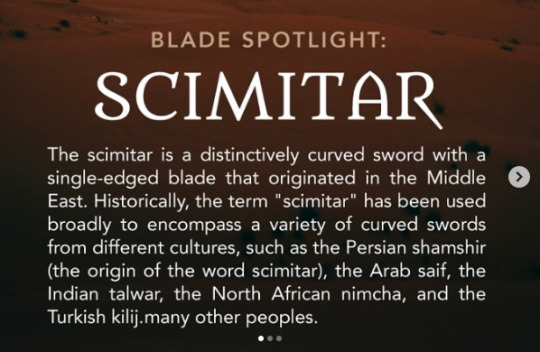
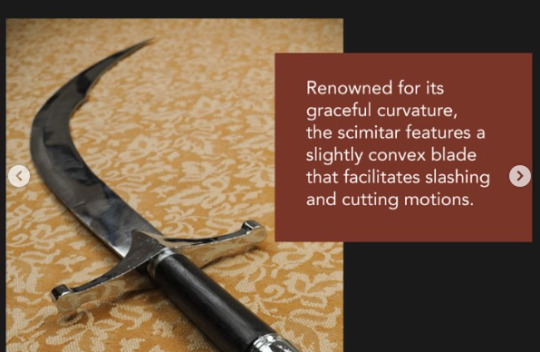
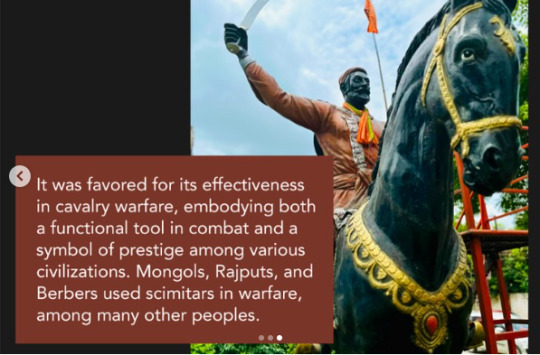
Embrace the elegance of the scimitar! This distinctively curved sword with a single-edged blade has a rich history originating in the Middle East. From the Persian shamshir to the Indian talwar, the scimitar has been embraced by various cultures. Discover the beauty and power of this iconic weapon at Kultofathena.com.
#Kult of Athena#KultofAthena#WorldOfKOA#sword#swords#weapon#weapons#blade#blades#Scimitar#Middle Eastern Indian & N. African Swords#Middle Eastern Indian & N. African Weapons#Belly Dance Swords#Battle Ready#Decorative
0 notes
Text
instagram
✨New from Universal Swords✨
The Damascus and Silver Koftgari Indian Saber with Ram’s Head is paired with a wood-core scabbard overlaid in vibrant velvet. Its steel components were decorated with silver koftgari to match the sword. The Damascus steel blade is crafted from the melding of two different steels into a single billet from which the smith forges the blade; the mixed steel leaves a vibrantly visible rippled patterning on the blade surface. Traditionally this was a technique done to merge harder and softer steels into a single blade to impart it with both a hardness for durability and edge retention and a degree of flexibility to prevent the blade from becoming brittle.
In stock and available to order now
#Kult of Athena#KultOfAthena#Koftgari Indian Saber#Damascus and Silver Koftgari Indian Saber with Ram’s Head#Universal Swords#Middle Eastern Indian & N. African Swords#sword#swords#weapon#weapons#blade#blades#sabers#Damascus Steel#Battle Ready#Indian Swords#Indian Weapons#Middle Eastern Swords#Middle Eastern Weapons#Instagram#videos
1 note
·
View note
Text




Damascus and Silver Koftgari Indian Saber with Ram’s Head – Universal Swords
This ornate and entirely handcrafted saber from India with its damascus blade and koftgari-inlay embellishment is in itself a display of the traditional swordsmithing arts of India. The damascus steel blade features panels of silver inlay on both sides of the blade. The blade tang is secured by filling the hollow hilt and grip with a hardened resin to solidly anchor it into the hilt. This method of sword construction is a traditional technique in India.
The sword is paired with a wood-core scabbard overlaid in vibrant velvet. Its steel components were decorated with silver koftgari to match the sword. The Damascus steel blade is crafted from the melding of two different steels into a single billet from which the smith forges the blade; the mixed steel leaves a vibrantly visible rippled patterning on the blade surface. Traditionally this was a technique done to merge harder and softer steels into a single blade to impart it with both a hardness for durability and edge retention and a degree of flexibility to prevent the blade from becoming brittle.
This was done to get good results from the quality of iron available for smithing. Damascus is now technically inferior to pure steel made from modern industrial-scale methods, but it is still desired as the beauty of Damascus is instantly notable and is a testament to the skill of the smith who forged it with the traditional methods and the blade was further embellished with silver inlay at the base of the blade. The elegant and intricate design and patterning on the hilt was created with the laborious Koftgari technique; a traditional process exemplified by Indian smiths whereby a design is etched and chiseled and then strands of silver wire is carefully hammered into the etched design. The hilt is then heated in a kiln and the silver wire is then permanently annealed into a permanent design.
The patterning of the damascus blade varies with each blade in much the same manner as all fingerprints differ. Also the Koftgari designs are made to the individual design and artistry of the smith. Therefore every one of the swords of this type are uniquely crafted and are a testament to the traditional swordsmithing techniques of India.
Please Note: Unique Item – Only One Available!
#Kult of Athena#KultOfAthena#New Item Wednesday#Koftgari Indian Saber#Damascus and Silver Koftgari Indian Saber with Ram’s Head#Universal Swords#Middle Eastern Indian & N. African Swords#sword#swords#weapon#weapons#blade#blades#sabers#Damascus Steel#Battle Ready#Indian Swords#Indian Weapons#Middle Eastern Swords#Middle Eastern Weapons
1 note
·
View note